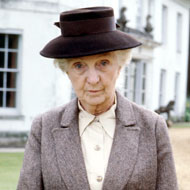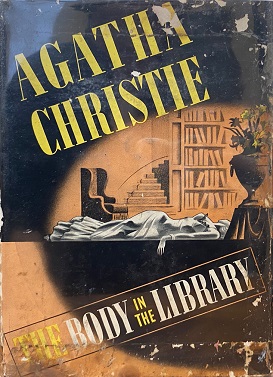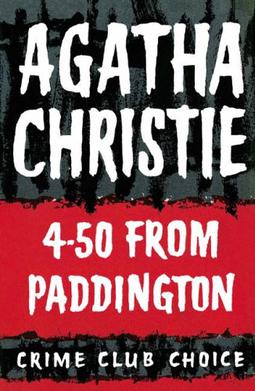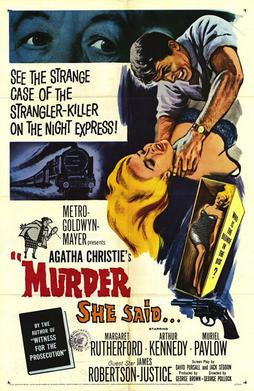Miss Jane Marple is a fictional character in Agatha Christie's crime novels and short stories. Miss Marple lives in the village of St. Mary Mead and acts as an amateur consulting detective. Often characterized as an elderly spinster, she is one of Christie's best-known characters and has been portrayed numerous times on screen. Her first appearance was in a short story published in The Royal Magazine in December 1927, "The Tuesday Night Club", which later became the first chapter of The Thirteen Problems (1932). Her first appearance in a full-length novel was in The Murder at the Vicarage in 1930, and her last appearance was in Sleeping Murder in 1976.

Sleeping Murder: Miss Marple's Last Case is a work of detective fiction by Agatha Christie and first published in the UK by the Collins Crime Club in October 1976 and in the US by Dodd, Mead and Company later in the same year. The UK edition retailed for £3.50 and the US edition for $7.95.

St Mary Mead is a fictional village created by popular crime fiction author Dame Agatha Christie.

Murder with Mirrors is a 1985 British-American television film starring Helen Hayes and Bette Davis. It is based on Agatha Christie's novel They Do It with Mirrors, using the novel's American title. The novel has been dramatized on two separated series, Miss Marple and Agatha Christie's Marple. They used the novel's original title.

Joan Bogle Hickson, OBE was an English actress of theatre, film and television. She was known for her role as Agatha Christie's Miss Marple in the television series Miss Marple. She also narrated a number of Miss Marple stories on audiobooks.

The Mirror Crack'd is a 1980 British mystery film directed by Guy Hamilton from a screenplay by Jonathan Hales and Barry Sandler, based on Agatha Christie's Miss Marple novel The Mirror Crack'd from Side to Side (1962). It stars Angela Lansbury, Geraldine Chaplin, Tony Curtis, Edward Fox, Rock Hudson, Kim Novak, and Elizabeth Taylor. Scenes were filmed at Twickenham Film Studios in Twickenham, London, and on location in Kent.

The Body in the Library is a work of detective fiction by Agatha Christie and first published in the US by Dodd, Mead and Company in February 1942 and in the UK by the Collins Crime Club in May of the same year. The US edition retailed at $2.00 and the UK edition at seven shillings and sixpence. The novel features her fictional amateur detective Miss Marple.

A Murder Is Announced is a work of detective fiction by Agatha Christie, first published in the UK by the Collins Crime Club in June 1950 and in the US by Dodd, Mead and Company in the same month. The UK edition sold for eight shillings and sixpence (8/6) and the US edition at $2.50.

They Do It with Mirrors is a detective fiction novel by British writer Agatha Christie, first published in the US by Dodd, Mead and Company in 1952 under the title of Murder with Mirrors and in UK by the Collins Crime Club on 17 November that year under Christie's original title. The US edition retailed at $2.50 and the UK edition at ten shillings and sixpence (10/6). The book features her detective Miss Marple.

4.50 from Paddington is a detective fiction novel by Agatha Christie, first published in November 1957 in the United Kingdom by Collins Crime Club. This work was published in the United States at the same time as What Mrs. McGillicuddy Saw!, by Dodd, Mead. The novel was published in serial form before the book was released in each nation, and under different titles. The US edition retailed at $2.95.

Murder, She said is a 1961 comedy/murder mystery film directed by George Pollock, based on the 1957 novel 4.50 from Paddington by Agatha Christie. The production stars Margaret Rutherford as Miss Marple, along with Arthur Kennedy, Muriel Pavlow, James Robertson Justice, and Stringer Davis.

Murder at the Gallop (1963) is the second of four Miss Marple films made by Metro-Goldwyn-Mayer. It was based on the 1953 novel After the Funeral by Agatha Christie, with Margaret Rutherford as Miss Jane Marple, Charles "Bud" Tingwell as Inspector Craddock and Stringer Davis as Jane Marple's friend Mr Stringer returning from the previous film.

Murder Most Foul is the third of four Miss Marple films made by Metro-Goldwyn-Mayer. Loosely based on the 1952 novel Mrs McGinty's Dead by Agatha Christie, it stars Margaret Rutherford as Miss Jane Marple, Charles Tingwell as Inspector Craddock, and Stringer Davis as Mr Stringer. The story is ostensibly based on Christie's novel, but notably changes the action and the characters. Hercule Poirot is replaced by Miss Marple and most of the other characters are not in the novel.

Murder Ahoy! is the last of four Miss Marple films made by Metro-Goldwyn-Mayer that starred Margaret Rutherford. As in the previous three, Murder, She Said (1961), Murder at the Gallop (1963), Murder Most Foul (1964), the actress plays Agatha Christie's amateur sleuth Miss Jane Marple, with Charles 'Bud' Tingwell as (Chief) Inspector Craddock and Stringer Davis playing Mr. Stringer.
John Michael Frederick Castle is an English actor. He is best known for his film and television work, most notably playing Bill in Michelangelo Antonioni's Blowup (1966) and Geoffrey in The Lion in Winter (1968). Other significant credits include Man of La Mancha (1972), I, Claudius (1976) and RoboCop 3 (1993).

Agatha Christie's Marple is a British ITV television programme loosely based on the books and short stories by British crime novelist Agatha Christie. The title character was played by Geraldine McEwan from the first to the third series, until her retirement from the role, and by Julia McKenzie from the fourth series onwards. Unlike the counterpart TV series Agatha Christie's Poirot, the show took many liberties with Christie’s works, most notably adding Miss Marple’s character to the adaptations of novels in which she never appeared. Following the conclusion of the sixth series, the BBC acquired the rights for the production of Agatha Christie adaptations, suggesting that ITV would be unable to make a seventh series of Marple.

Miss Marple, titled Agatha Christie's Miss Marple in the series, is a British television series based on the Miss Marple murder mystery novels by Agatha Christie, starring Joan Hickson in the title role. It aired from 26 December 1984 to 27 December 1992 on BBC1. All twelve original Miss Marple novels by Christie were dramatised.
Lists of adaptations of the works of Agatha Christie:
Sir Henry Clithering is a fictional character who appears in a series of short stories by Agatha Christie, featuring Jane Marple. The stories were first published in monthly magazines starting in 1927, and then collected into a hard-bound collection, The Thirteen Problems in 1932. Clithering also appeared in several novels featuring Miss Marple.
Raymond West is a fictional character who appears or is mentioned in several of Agatha Christie's novels and short stories featuring Jane Marple.















